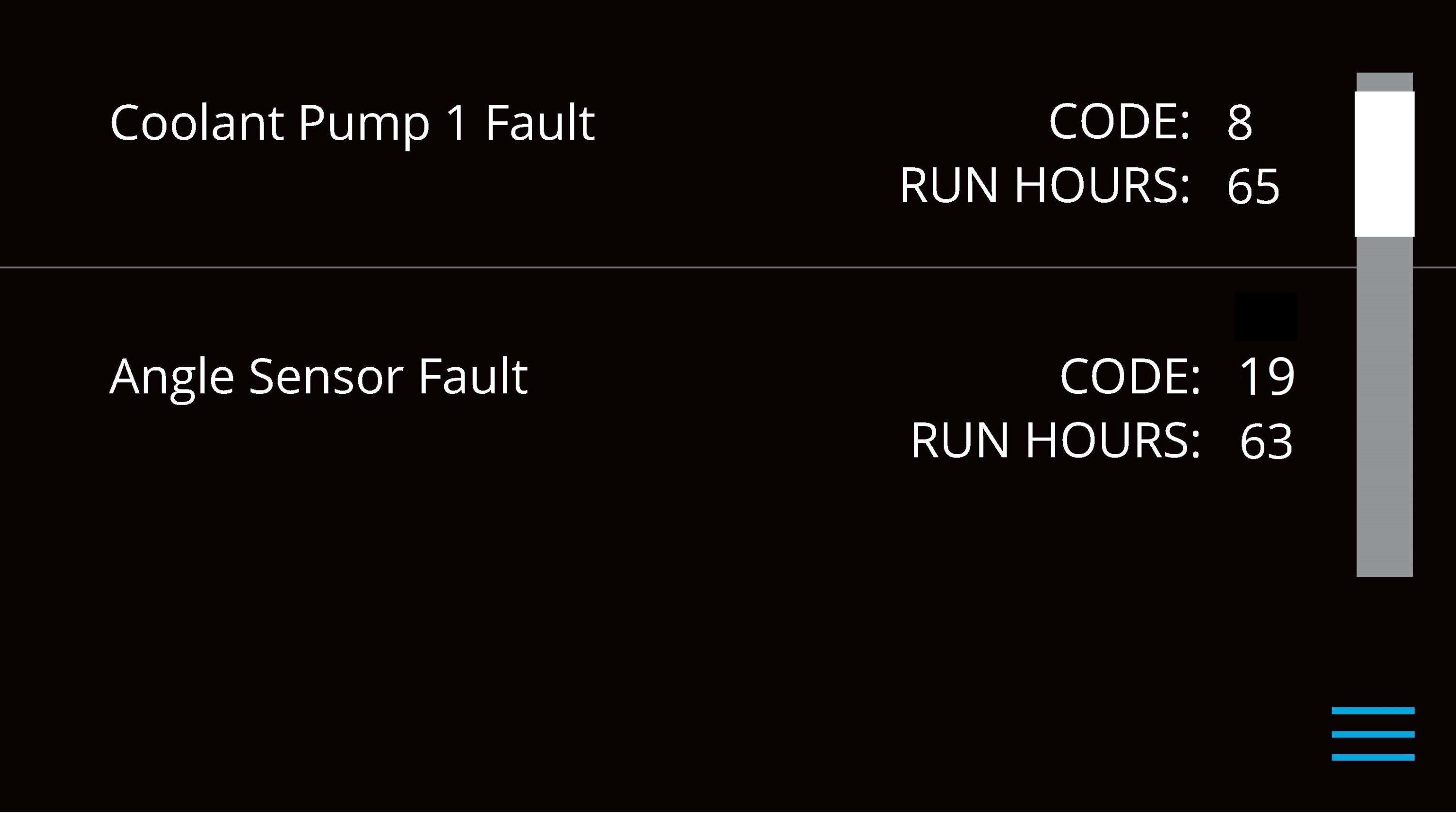Seakeeper 10 Operation Manual (90842-1)
4.0 Power Failures, Alarms, and Troubleshooting
4.1 Power Failures and Alarms Introduction
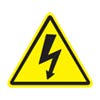
The Motor Drive Box contains hazardous voltage, and the cover should not be removed while the flywheel is spinning or the AC input voltage is present. This high voltage exists even if the flywheel is coasting down and the supply voltage has been shut off. The flywheel must be at 0 RPM and AC input power disconnected for at least 10 minutes before any service work on the motor drive box.
____________________________________________________________________________________________
The operator should physically examine the Seakeeper following an alarm. Continuing to reset alarms without service intervention can result in damage or personnel injury.
____________________________________________________________________________________________
The flywheel must be at Zero (0) RPM and AC input power disconnected for at least 10 minutes before any service work on the Seakeeper.
The Seakeeper 10 has safety features, such as alarms and warnings, that pop up on the Seakeeper app and are signaled on the ConnectBox to protect the Seakeeper and the vessel. The brake can be locked from the Seakeeper app, ConnectBox, or by shutting off power at the supply breakers, preventing the Seakeeper from precessing.
In the event of a DC control power failure, the brake automatically locks the Seakeeper so it cannot generate anti-rolling torque loads.
There are three sources of power to the Seakeeper 10:
- 24 VDC powers the Seakeeper for all the control electronics.
- 24 VDC powers the DC Seawater Pump for cooling water supply.
- 208 – 230 VAC powers the Motor Drive Box to drive the flywheel motor inside the Seakeeper sphere.
These are supplied on cables shown on Drawing No. 90719 – Seakeeper 10 Cable Block Diagram.
4.2 DC Power Failure
24 VDC Control Power
If the 24 VDC control power is disconnected during operation, the display will be blank, flywheel speed will decrease, and the brake will be locked (no precession or stabilization).
- Verify the boat’s circuit breaker supplying +24 VDC has not tripped and the AC breaker is On.
- When +24 VDC is restored, the display will power up, the Splash Screen will appear, and then the Home Screen will appear.
- Press Power On/Off button
 . The progress bar will appear and indicate flywheel speed. When the flywheel is at minimum operating speed, the Stabilize button will appear so stabilization can be turned on. This may take up to 30 minutes, depending on the speed of the flywheel when the +24 VDC is turned back on.
. The progress bar will appear and indicate flywheel speed. When the flywheel is at minimum operating speed, the Stabilize button will appear so stabilization can be turned on. This may take up to 30 minutes, depending on the speed of the flywheel when the +24 VDC is turned back on.
Seawater Pump Power
If Seawater Pump input DC power is disconnected during operation, the Seawater Pump will fail to provide cooling seawater flow when required. The resulting high temperatures would result in the Seakeeper being turned off (no stabilization) due to high temperature alarm(s).
- Verify the boat’s circuit breaker or fuse supplying DC Seawater Pump power has not tripped or blown.
- When DC SW Pump power is restored, reset any alarm and continue Seakeeper operation.
4.3 230 VAC Failure
AC Power Failure
If the AC power is not connected, a notification screen will indicate “AC Mains Low”. If the failure is not corrected within two minutes, an “AC Mains Low” alarm will occur. The brake will lock and the Seakeeper will stop moving if stabilization was on.
- Verify the boat’s circuit breaker supplying 208-230 VAC to the Motor Drive Box has not tripped.
- Restore Seakeeper AC power.
- Press Power On/Off button
 to clear the alarm. The progress bar will appear and indicate flywheel speed. When the flywheel is at minimum operating speed, the Stabilize button will appear (On the ConnectBox user interface, the Stabilize button will flash) so stabilization can be turned on. This may take up to 30 minutes, depending on the speed of the flywheel when the 208-230 VAC is turned back on.
to clear the alarm. The progress bar will appear and indicate flywheel speed. When the flywheel is at minimum operating speed, the Stabilize button will appear (On the ConnectBox user interface, the Stabilize button will flash) so stabilization can be turned on. This may take up to 30 minutes, depending on the speed of the flywheel when the 208-230 VAC is turned back on.
AC Power Fluctuation, Spike, or Momentary Failure
If the AC voltage to the Motor Drive Box is outside Seakeeper’s specified range (208 – 230 VAC), the Motor Drive Box will briefly shut down for protection. The Motor Drive Box will continue operation when the voltage returns to the specified range.
A brief fluctuation can happen when the generator cannot regulate its output voltage, particularly when a large AC load is switched on or off. A momentary AC failure also occurs during the transition from shore power to ship power.
4.4 Alarms and Notifications
Alarms

The operator should physically examine the Seakeeper following an alarm. Continuing to reset without service intervention can result in personnel injury or damage.
Sensors, alarms, and shutdowns are provided to allow unattended operation. Sensors measure drive temperatures, gimbal angle, brake pressure, and vessel motion. The Seakeeper controller sends sensor values and alarm information to the display. The Seakeeper locks the brake and shuts down the motor drive in the event of an alarm condition. Seakeeper operating history during faults or alarms is recorded in the controller’s memory for subsequent recall if service is needed. Seakeeper and Seakeeper Dealers may access the Seakeeper’s software to gather run hours, bearing loading, and hull slamming information.
NOTE: Only the MFD app or the Seakeeper 5” Touch Display can identify and address the alarm. The alarm will not clear until the operator presses the Reset Alarm button, AND the alarm condition is no longer present. After the alarm is reset, the operator can then press the POWER button again to resume Seakeeper operation.
- A view of a typical Alarm screen.
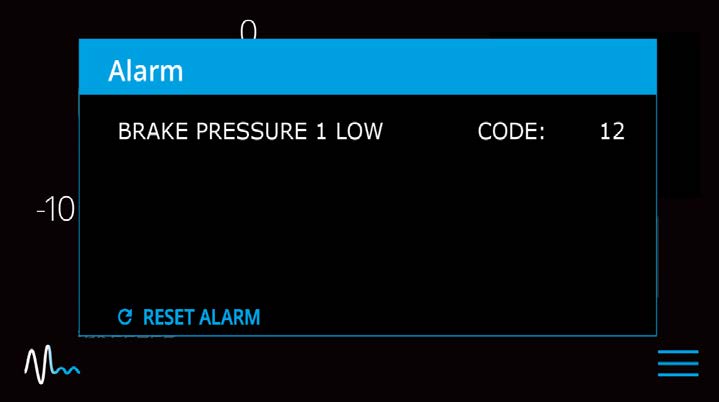
- To reset the alarm, press the Reset Alarm button:

Troubleshooting
- At MFD app or 5″ Touch Display, check for alarms or warnings.
- Power Supply: Check electrical power breakers ON or fuses installed and NOT blown.
- Mechanical Components:
- For temperature-related alarm, verify the coolant reservoir is filled with glycol mixture (50% ethylene glycol/50% distilled water). Verify seawater pump power aligned.
- Visually check mechanical fittings and joints for leakage.
- Visually check coolant and brake hoses for chaffing and leakage.
- Contact an authorized Seakeeper dealer for further assistance in diagnosing and resolving complex alarms.

If a GPS signal is lost, a warning message will appear in the Alarm History and a message will appear on the Home Screen, as seen below. The Seakeeper will not spool down, however the precession rate and angle of the sphere will be reduced until GPS signal returns.
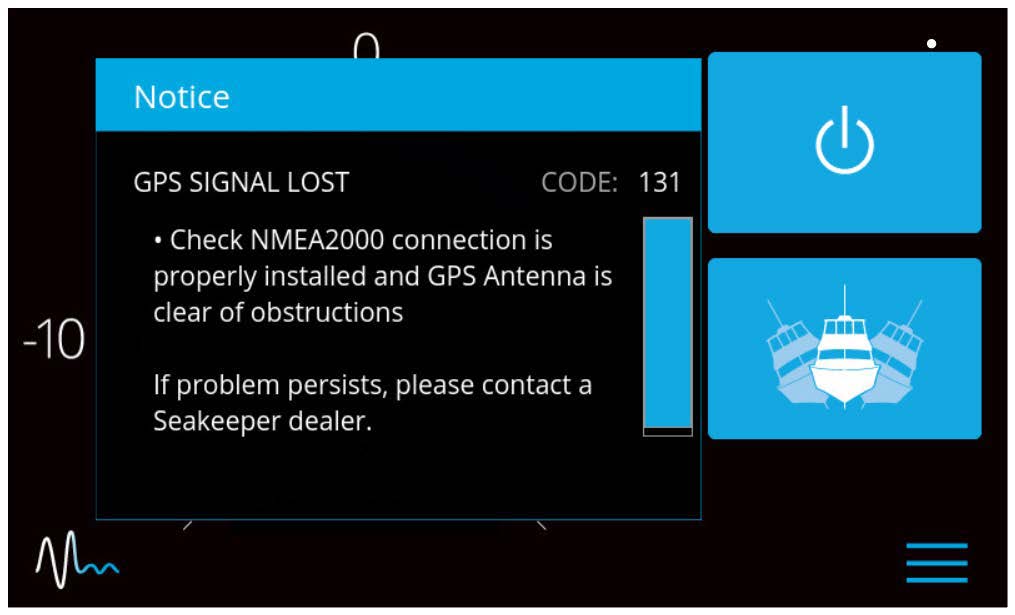
Notifications
Several notifications are programmed to pop up upon certain events. They do not affect the operation of the Seakeeper, and each notification may be dismissed or suppressed.
Rinse Reminder
Upon pressing power button to turn OFF Seakeeper and start coast down, the Rinse Reminder notification will appear to remind the user to rinse the Seakeeper with mild soap and fresh water after use. Pressing the OK button will acknowledge the notification and it will not reappear until the next coast down event.
The QR code links the user to the Freshwater Rinse article on the Seakeeper website. If the Seakeeper was exposed to saltwater spray, it is desirable to rinse the Seakeeper to maintain cosmetic condition.

Maintenance Reminder
Seakeeper recommends routine service every 1000 run hours to maintain the Seakeeper in peak condition. To assist the user in Seakeeper maintenance, the Maintenance Service Reminder will appear after 1000 Run Hours has elapsed since the last reset of the Service Reminder. The “Next Service Reminder” timer can be found in the Service page, as shown below. Below the Next Service Reminder timer is the reset button that resets the timer to 1000 Run Hours.

When the timer reaches 0 Run Hours, the notification will appear in a popup on the Seakeeper app. The user has an option to suppress the reminder until the next Seakeeper power cycle by selecting “Remind Me Later” or the user can reset the timer by selecting the “Reset Service Reminder”.
The QR code links the user to the Seakeeper Recommended Maintenance Schedule on the Seakeeper website.
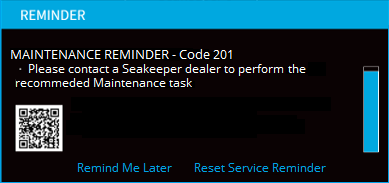
Warranty Registration Reminder
Before warranty work can occur, a Seakeeper must be registered. Registering your Seakeeper before warranty service is required is recommended to allow for expedient service if needed. Registration also includes the user in any important Seakeeper notifications that may affect their unit.
At 20 Run Hours on the Seakeeper, a Registration Reminder notification will appear on the Seakeeper app. The reminder occurs only once in the life of the Seakeeper. To dismiss the reminder, press OK on the popup window.
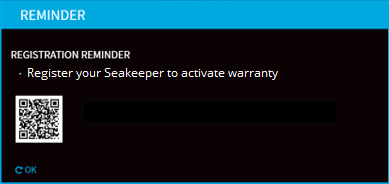
4.5 Alarm History
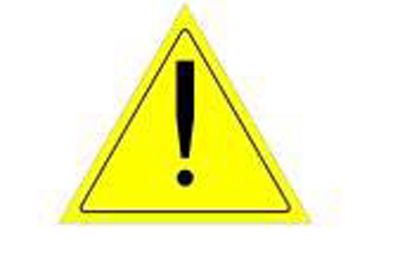
The operator should physically examine the Seakeeper following an alarm. Continuing to reset alarms without service intervention can result in personnel injury or damage.
The ALARM HISTORY page on the Seakeeper application or display shows the recent alarms and warnings. Alarms trigger a pop-up message to be displayed on the display or Seakeeper App. Warnings will be listed in the alarm history but do not affect Seakeeper operation. The alarms and warnings are in chronological order starting with the most recent. Warnings included in the history page are for issues that do not affect gyrostabilizer operation. The Seakeeper can hold up to 32 alarms in history. Each alarm, after 32 alarms are stored in history, will cause the oldest stored alarm to drop off.
Press the Menu button ![]() to show the page options and then the Alarm button
to show the page options and then the Alarm button ![]() to show alarm history.
to show alarm history.
